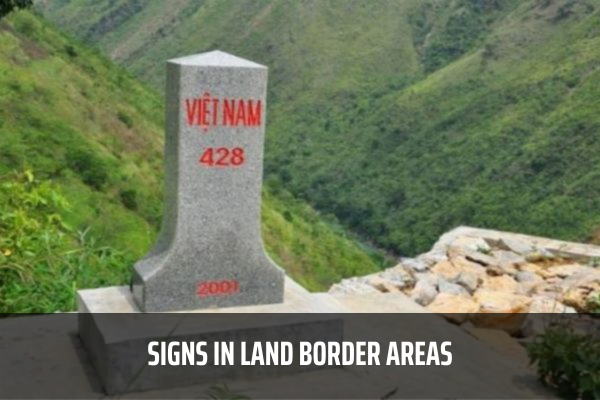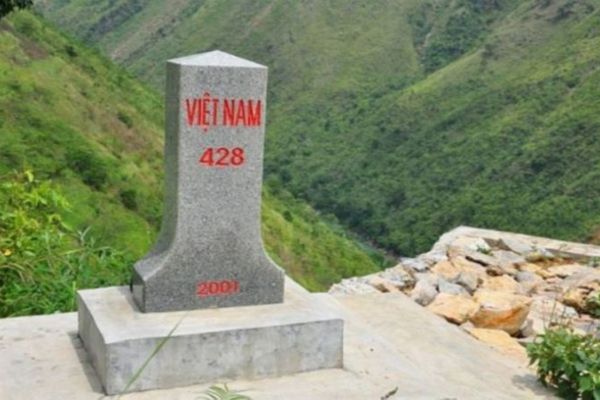What are the signs in land border areas of Vietnam under the Decree 34/2014/ND-CP?
What are the signs in land border areas of Vietnam under the Decree 34/2014/ND-CP?
Pursuant to the provisions of Article 9 of Decree 34/2014/ND-CP, it clearly states that signs in land border areas are as follows:
Signs in land border areas
1. In land border areas, there are “border area”, “border belt” and “restricted zone” signs and other signs prescribed by law.
2. The Minister of National Defense shall set model signs and reach agreement with provincial-level People’s Committees on positions for putting up “border area”, “border belt” and “restricted zone” signs prescribed in Clause 1 of this Article.
Thus, pursuant to Decree 34/2014/ND-CP, In land border areas, there are signs including:
- “border area” signs
- “restricted zone”signs
- Other signs prescribed by law.

What are the signs in land border areas of Vietnam under the Decree 34/2014/ND-CP? (Image from the Internet)
Vietnam: Where will the “border area” sign be placed?
Pursuant to the provisions of Article 5 of Circular 43/2015/TT-BQP, model signs and positions for sign placing are as follows:
Model signs and positions for sign placing
1. The signs “khu vuc bien gioi” (border area), “vanh dai bien gioi” (border belt) and “vung cam” (restricted zone) shall be uniformly made of corrugated iron 1,5mm thick, with posts being of steel tube of 100 mm in diameter and 2mm thick; the signs’ surface and inscriptions must be retroreflective; the signs’ background must be painted blue and inscriptions, white, and the signs’ retroreflective posts, while and red; inscriptions on the signs must be written in three lines: The first line in Vietnamese, the second line in the language of the opposite country, and the third line in English. The sizes of the signs and characters thereon must comply with Form Nos.l thru 12 provided in the Appendix to this Circular (not translated).
2. The sign “khu vuc bien gioi” shall be placed in adjacent areas between border communes, wards or townships and inland communes, wards or townships in easy-to-notice places by traffic axes (land road, railroad, riverway) leading to border areas.
3. The sign “vanh dai bien gioi”:
a/ In border areas with mountains and forests which are difficult to access, the sign “vanh dai bien gioi” shall be placed at the right of traffic axes towards the border.
b/ In border areas with flat terrains difficult to distinguish boundaries, the sign “vanh dai bien gioi” shall be placed in an interval of between 600m and 1,000 m.
c/ The sign “vanh dai bien gioi” shall not be placed along traffic axes from the inland to border gates, but on both sides of the boundaries of the border gates.
4. Based on the terrains and characteristics of each restricted zone, the sign “vung cam” shall be placed at suitable and easy-to-notice places.
According to the above regulations, the location of the “border area” sign is as follows:
The "border area" sign shall be placed in adjacent areas between border communes, wards or townships and inland communes, wards or townships;
At the same time, the location of the sign is in easy-to-notice places by traffic axes (land road, railroad, riverway) leading to border areas.
What are the cases of suspension of activities in land border areas of Vietnam?
Pursuant to the provisions of Article 10 of Decree 34/2014/ND-CP, there are provisions as follows:
Suspension of activities in land border areas
1. Areas subject to and cases of suspension:
a/ Areas in which a border or territory dispute occurs, threatening the sovereignty and security of the national border;
b/ Areas in which an armed conflict, robbery, terrorist action, riot, intrusion, kidnapping or serious security and order disturbance occurs;
c/ Areas in which a natural disaster, mishap, epidemic, chemical or radioactive incident occurs, threatening to cause damage to the community or cross-border transmission;
d/ Upon receipt of notices of the Government, local administrations or border-guard forces of neighbor countries on suspension of traveling across the border.
2. In order to ensure safety for lives and properties of people, prevent natural disasters, fires, floods, epidemics or diseases, the following activities must be suspended:
Entering the border belt, opening up markets, organizing festivals, conducting production, business or construction, exploring and exploiting natural resources and other activities in the areas or cases specified in Clause 1 of this Article.
3. Persons competent to suspend activities in land border areas are prescribed as follows:
a/ Commanders of border-guard posts may decide to suspend for no more than 12 hours activities within the border belt in localities under their charge and shall report the suspension to the chief commanders of provincial-level Border-Guard Commands and concurrently notify such in writing to local district- and commune-level People’s Committees and related agencies in land border areas as well as local administrations and border management and guard forces of neighbor countries;
b/ Chief commanders of provincial-level Border-Guard Commands may decide to suspend for no more than 24 hours activities in land border areas under their charge and shall report such in writing to provincial-level People’s Committees and the Border Guard Commands and concurrently notify such to provincial-level Public Security Departments and border management and guard forces of neighbor countries;
In case chief commanders of provincial-level Border-Guard Commands find it necessary to continue to suspend activities in land border areas upon the expiration of the time limit of 24 hours, they shall request provincial-level People’s Committees to decide to prolong the suspension for another 24 hours, and concurrently notify such to provincial-level Public Security Departments and border management and guard forces of neighbor countries.
4. Competent persons specified in Clause 3 of this Article shall notify in writing to the Ministry of Foreign Affairs for coordinated handling when necessary, take responsibility before law and immediate superior agencies for their suspension decisions. Upon the expiration of the permitted suspension time limit or when the above occurrences are over, they shall issue decisions to cancel suspension decisions, notify such decisions in writing to related agencies, border management and protection forces of neighbor countries and announce them on the mass media.
According to the above regulations, areas subject to and cases of suspension:
- Areas in which a border or territory dispute occurs, threatening the sovereignty and security of the national border;
- Areas in which an armed conflict, robbery, terrorist action, riot, intrusion, kidnapping or serious security and order disturbance occurs;
- Areas in which a natural disaster, mishap, epidemic, chemical or radioactive incident occurs, threatening to cause damage to the community or cross-border transmission;
- Upon receipt of notices of the Government, local administrations or border-guard forces of neighbor countries on suspension of traveling across the border.
In addition, in order to ensure safety for lives and properties of people, prevent natural disasters, fires, floods, epidemics or diseases, the activities of entering the border belt, opening up markets, organizing festivals, conducting production, business or construction, exploring and exploiting natural resources and other activities in the areas mentioned above must be suspended:
LawNet
